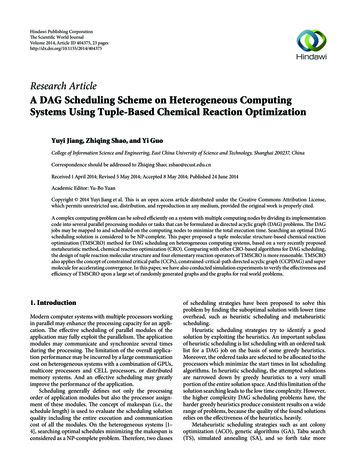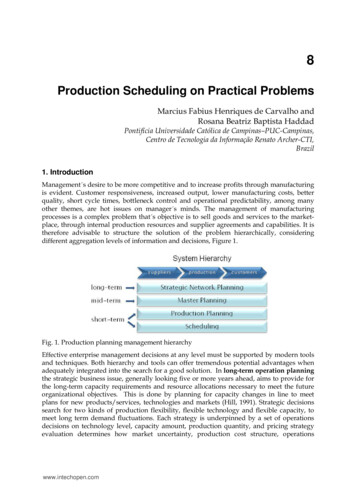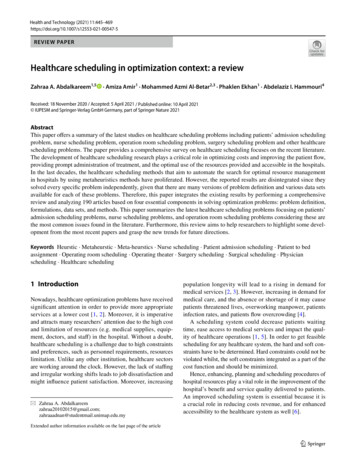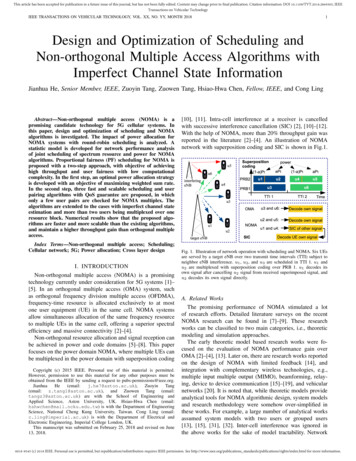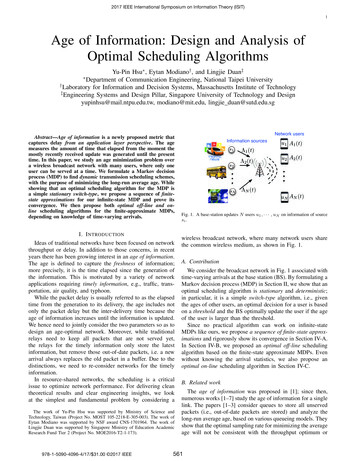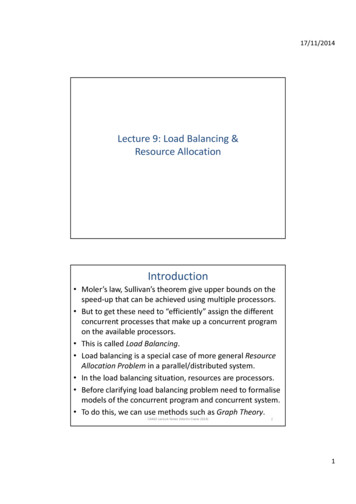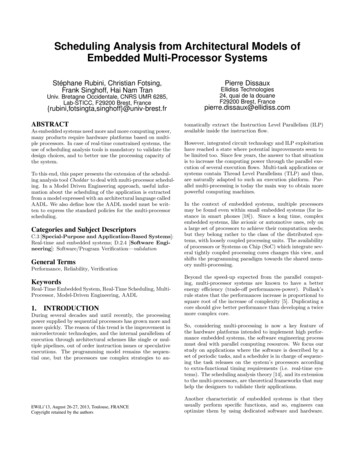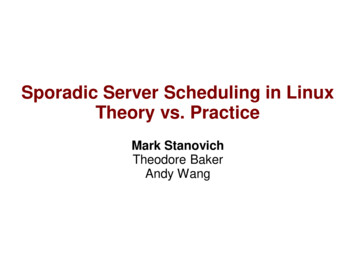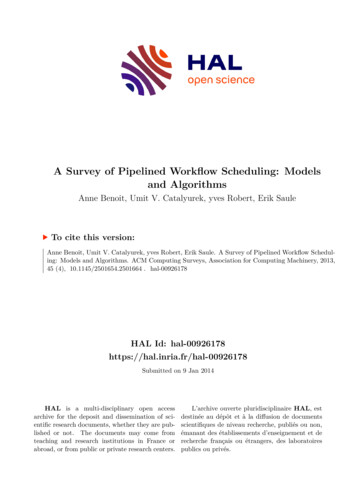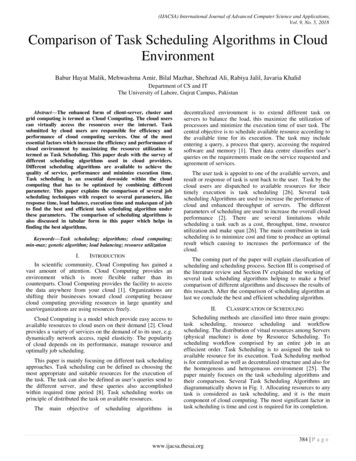
Transcription
(IJACSA) International Journal of Advanced Computer Science and Applications,Vol. 9, No. 5, 2018Comparison of Task Scheduling Algorithms in CloudEnvironmentBabur Hayat Malik, Mehwashma Amir, Bilal Mazhar, Shehzad Ali, Rabiya Jalil, Javaria KhalidDepartment of CS and ITThe University of Lahore, Gujrat Campus, PakistanAbstract—The enhanced form of client-server, cluster andgrid computing is termed as Cloud Computing. The cloud userscan virtually access the resources over the internet. Tasksubmitted by cloud users are responsible for efficiency andperformance of cloud computing services. One of the mostessential factors which increase the efficiency and performance ofcloud environment by maximizing the resource utilization istermed as Task Scheduling. This paper deals with the survey ofdifferent scheduling algorithms used in cloud providers.Different scheduling algorithms are available to achieve thequality of service, performance and minimize execution time.Task scheduling is an essential downside within the cloudcomputing that has to be optimized by combining differentparameter. This paper explains the comparison of several jobscheduling techniques with respect to several parameters, likeresponse time, load balance, execution time and makespan of jobto find the best and efficient task scheduling algorithm underthese parameters. The comparison of scheduling algorithms isalso discussed in tabular form in this paper which helps infinding the best algorithms.Keywords—Task scheduling; algorithms; cloud computing;min-max; genetic algorithm; load balancing; resource utilizationI.INTRODUCTIONIn scientific community, Cloud Computing has gained avast amount of attention. Cloud Computing provides anenvironment which is more flexible rather than itscounterparts. Cloud Computing provides the facility to accessthe data anywhere from your cloud [1]. Organizations areshifting their businesses toward cloud computing becausecloud computing providing resources in large quantity anduser/organizations are using resources freely.Cloud Computing is a model which provide easy access toavailable resources to cloud users on their demand [2]. Cloudprovides a variety of services on the demand of to its user, e.g.dynamically network access, rapid elasticity. The popularityof cloud depends on its performance, manage resource andoptimally job scheduling.This paper is mainly focusing on different task schedulingapproaches. Task scheduling can be defined as choosing themost appropriate and suitable resources for the execution ofthe task. The task can also be defined as user’s queries send tothe different server, and these queries also accomplishedwithin required time period [8]. Task scheduling works onprinciple of distributed the task on available decentralized environment is to extend different task onservers to balance the load, this maximize the utilization ofprocessors and minimize the execution time of user task. Thecentral objective is to schedule available resource according tothe available time for its execution. The task may includeentering a query, a process that query, accessing the requiredsoftware and memory [1]. Then data centre classifies user’squeries on the requirements made on the service requested andagreement of services.The user task is appoint to one of the available servers, andresult or response of task is sent back to the user. Task by thecloud users are dispatched to available resources for theirtimely execution is task scheduling [26]. Several taskscheduling Algorithms are used to increase the performance ofcloud and enhanced throughput of servers. The differentparameters of scheduling are used to increase the overall cloudperformance [2]. There are several limitations whilescheduling a task such as a cost, throughput, time, resourceutilization and make span [26]. The main contribution in taskscheduling is to minimize cost and time to produce an optimalresult which causing to increases the performance of thecloud.The coming part of the paper will explain classification ofscheduling and scheduling process. Section III is comprised ofthe literature review and Section IV explained the working ofseveral task scheduling algorithms helping to make a briefcomparison of different algorithms and discusses the results ofthis research. After the comparison of scheduling algorithm atlast we conclude the best and efficient scheduling algorithm.II.CLASSIFICATION OF SCHEDULINGScheduling methods are classified into three main groups:task scheduling, resource scheduling and workflowscheduling. The distribution of vitual resources among Servers(physical machine) is done by Resource Scheduling. Toscheduling workflow comprised by an entire job in aneffiecient order. Task Scheduling is to assigned the task toavailable resource for its execution. Task Scheduling methodis for centralized as well as decentralized structure and also forthe homogenous and hetrogenuous environment [25]. Thepaper mainly focuses on the task scheduling algorithms andtheir comparison. Several Task Scheduling Algorithms arediagrammatically shown in Fig. 1. Allocating resources to anytask is considered as task scheduling, and it is the maincomponent of cloud computing. The most significant factor intask scheduling is time and cost is required for its completion.384 P a g ewww.ijacsa.thesai.org
(IJACSA) International Journal of Advanced Computer Science and Applications,Vol. 9, No. 5, 2018resource allocation process is become more complex.Therefore, S. Ravichandran and D. E. Naganathan [7] hadproposed a new system to get rid from this problem, thissystem works when a new task is arrived it is sent into thequeue for waiting and the job scheduler will easily order eachtask and allocate resources for their execution. GeneticAlgorithm is considered as a best practice in this regard, allthe tasks are sent to the queue, scheduler pick the task fromthe queue allocate resources and execute the task. The centralpurpose of this system is to minimize the execution time of thetask and optimize the resource utilization.Fig. 1. Classification of scheduling techniques [2].III.SCHEDULINGDistributed computing environment comprised of severalscheduling techniques. These techniques is implemented tocloud environment with applicable parameters. The centralpurpose of these techniques is to improve the response time ofsystem and the performance of the cloud [3]. ConventionalScheduling techniques are not able to increase theperformance, it maximize the cost and execution time as well.Scheduling algorithms which are discussed in this paper aremin-min, First Come First Serve, Round Robbin, GeneticAlgorithm, Greedy Algorithm, Partical Swarm Optimization,Priority based scheduling, etc. [4], [24].A. Scheduling ProcessCloud Task scheduling process is generally classified intothree stages [7] are shown in Fig. 2:Resource Dicorvey and Filtering: The cloud serviceprovider discover list of available resource in a secificnetwork and also collect and check their working status.Selction of Resources: It is the most important stage in taskscheduling, is also known as deciding stage. Requiredresources are selected on specific parameter and according tothe requiremt of task execution.Submission of Task: After slecting the required resourcethe task is submit to the resource for execution [34].In this paper authors, V. V. Kumar and S. Palaniswamimainly focused on enhancing the efficiency of job schedulingtechniques for cloud computing service. They have alsopurposed an algorithm which optimally utilized the turnaroundtime by giving high priority to different job for its completionand less priority for termination issues of real-time task [9]Moreover, a new task scheduling algorithm was purposedby Z. Zheng which is based on genetic algorithm which istermed as Parallel Genetic Algorithm. The main objective ofthis algorithm is to optimize the cloud scheduling problemmathematically.Siad Bin Alla and Hicham Bin Alla in [22] have explaineda novel based dynamic task scheduling technique which isbased on improved genetic algorithm. The working ofproposed algorithm is mainly focused to reduce the executiontime, effectively improve the throughput and the scalability ofthe cloud in task scheduling.In [33], author proposed a novelistic approach for taskscheduling algorithm M Quality of Service with GeneticAlgorithm and Ant Colony “QOS-GAAC” with multi-QOSconstraint, in this algorithm author mainly focused onexpenditures, security, time-consuming and reliability in theprocess of task scheduling. This algorithm is the combinationof genetic Algorithm and ant colony optimization algorithm.The result represent that this algorithm has great performancein both guaranteeing QOS and resource balancing in taskscheduling [27].Author proposed an optimized algorithm to minimize thecost and bi-objective makespan used by heuristic searchtechniques for independent tasks scheduling [32]. Integer PSOis a new variant is proposed; the main objective of this variantis to solve the task scheduling problem in cloud. Integral-PSOis an improved and continuous form of Particle swarmoptimization.V.Fig. 2. Task scheduling process [4].IV.LITERATURE REVIEWThe major issue in task scheduling is the allocation ofefficient and available resources to the new task enter by theuser. If several tasks arrive at the same time, then dynamicallyTASK ANALYSIS ALGORITHMSA. Genetic AlgorithmThe most transformative algorithms are the geneticalgorithms which are dependent on the concept of naturaltransformation [14]. This genetic algorithm is promptlyemerging in the field of artificial intelligence [6], [3]. It workson the processing of every task as shown in Fig. 3, in whichthe quality of each task is being processed according to theuser requirements unless the user is being satisfied [9].Darwin’s theory introduced the idea of “Survival of the fittest”which basically processes the tasks according to their385 P a g ewww.ijacsa.thesai.org
(IJACSA) International Journal of Advanced Computer Science and Applications,Vol. 9, No. 5, 2018allocation to the resources on the base of their fitness valuefunctions [12]. It doesn’t process that task as whole rather itevaluates each parameter of that task on basis of fitness value[4] [20]. The generic terms of this algorithm are as follow:a) Initial PopulationIn this algorithm there are several number of individualswhich operates the tasks in an iterative way and so severalnumber of solutions are being fixed up, such solutions aretermed as populations, in every specific iteration. In thatpopulation every solution is termed as chromosome. Tenchromosomes are being selected from that population [5].From this an initial population, ten chromosomes are selectedunsystematically [6].b) Fitness FunctionThe basic purpose of this function is quality evaluation ofeach individual in population while depending upon approachof optimization. It is more often dependent on deadline but infew cases it is dependent on the budget constraints [7].c) SelectionIn this process an operator is used known as proportionalselection which is used for evaluating the probability andfitness between two algorithms. It identifies that eitherselected probability or next groups are proportional to fitnessof each individual [10].B. Greedy AlgorithmGreedy Algorithm is used for solving the problems bymaking decisions considered best in that particular situation.Working of Greedy Algorithm is explained in Fig. 4.Optimization issues can be easily solved with the help of thisalgorithm. Though some problems do not seem easy enoughwith efficient solutions but they are being solved with the helpof greedy algorithm with the finest solutions [11]. There aresome deviations to the greedy algorithm: Pure greedy algorithms Orthogonal greedy algorithms Relaxed greedy algorithmsWhen some agitations occur such as bad weather and soon, few constraints in above model are being effected due towhich the entire schedule become totally unworkable. Thebasic purpose of this algorithm was to overcome suchproblems in each and every step and makes the finestdecisions. Its main aim was to get the finest solution and keepon working that schedule unless all the problems are beingsolved [13]. Due to this optimization of the large problem wasdivided into small size problems and this helped inidentification of solutions in less time [12]. Basic working ofGreedy Algorithm is as follows:d) CrossoverPurpose of this process is the selection of best fitted pair ofindividuals for crossing over and this is not done without theusage of an operator known as single-point crossover operator.The benefit of crossing over is that both sides’ portions can beexchanged [6], [10].e) MutationNew individuals are not generated in easy way for thatpurpose; some of gene locus is being substituted by other genelocus values and it is done in the coding series. A very smallvalue (0.05) is chosen as mutation probability [11].Fig. 4. Working of Greedy Algorithms [12].Some standards of Greedy Algorithm are as follows [12]:Fig. 3. Working of Genetic Algorithms [5].a) Kruskal’s Minimum Spanning Tree (MST)In this MST is created by selecting edges not collectivelybut individually. The greedy choice is always selecting theedge of lightest weight because it wouldn’t create a cycle inMST.386 P a g ewww.ijacsa.thesai.org
(IJACSA) International Journal of Advanced Computer Science and Applications,Vol. 9, No. 5, 2018b) Prim’s Minimum Spanning TreeMST is being created again in it but we manage two sets:set of vertices which are already being added up in MST andthe set of vertices which is not added yet. Those edges areselected which are less in weight [11].c) Dijkstra’s Shortest PathIt is very similar to Prim’s algorithm. In this the shortestpath tree is being built up by every single edge. We managetwo sets: set of vertices which are already being added up inMST and the set of vertices which is not added yet [18].Greedy choice is selection of the smallest weight path.d) Huffman CodingLoss-less compression technique is considered as the baseof this algorithm. It allocates variable length bit codes todifferent characters. The Greedy Choice is to assign least bitlength code to the most frequent character [11], [12].C. Priority-based Job Scheduling AlgorithmIn Cloud computing, an innovative approach to deal withprogramming work is presented by Shamsollah Ghanbari andMohamed Othman by using mathematical measurements [19].The significance of the job for programming is considered bythis algorithm and is called the Algorithm for priority basedjob scheduling algorithm “PJSC”. It is centred as themultiplicative standards decision-making model. There arethree levels of priorities in this algorithm that areprogramming level, resource level and work level which isshown in Fig. 5.Now the PVS (priority vector of S) is calculated in thisalgorithm and S is stated as a set of jobs. The matrix Δ ismultiplied with the matrix γ which is resulted as PVS. Nowthe highest ranked job is chosen, and resource is allocated tothat job. Job’s list is upgraded with the time, and theprogramming procedure proceeds until the point that all jobsare planned in a suitable resource [33]. The trial/experimentscome about show that the calculation of the algorithm has therational complexity. There are additionally a few issuesidentified with this calculation, for example, completion time,consistency and complexity [19], [21].D. Round RobinThe round robin is a simple example of load balancingtechnique. A round robin technique was designed to dividescheduling time among all scheduled task equally, in which alltasks get in queue list, and each task gets an equally small unitof time as clearly explained in Fig. 6. The major concern ofRR is to focus on dividing load to all resources equally [14]. Acyclic approach is applied in round robin. The schedulerpicked a task and assigned to the controller and after timeexpires of the first task then move to next task [17]. This is thecyclic approach in which all task assigned to the controller atleast once and then scheduler again pick up the first taskagain.Fig. 5. Three level of priority based scheduling [20].Fig. 6. Load Balancer Round Robin [10].In this algorithm jobs set are taken as J {J1, J2, J3,J, ,Jm} that demands assets in a cloud atmosphere andresources set are taken as C { C1, C2, C3, C4, .,Cd} that ispresented in cloud atmosphere as input where (d m). Eachjob set demands a resource with the required priority. Priorityof different jobs set is compared independently [28]. Each jobis allocated a resource with the specified priority. Hence, thecorrelation networks of each activity/job set are computedaccording to the prospects of retrieving the resources, and thematrix of comparison of the resources is also computed. Nowthe normal matrix of all jobs with the name Δ is calculated bycomparing the each of the job set matrices and priority pathsare also calculated [21]. Then the normal resources matrix iscalculated, and the name of the matrix is given as γ.The load balancing and response time are much bettercompared to other algorithms. The working of Round Robin incloud environment is same as round robin in processscheduling [15]. In round robin, each task has an equalopportunity to be chosen [28].E. Min-Min AlgorithmThis scheduling technique works on strategy in which taskhas minimum execution time is selected for all task. Thisalgorithm starts when a set of all jobs are not assigned andcontinue to execute until the whole set of the job is empty[16]. In Min-Min jobs having the greater time or long taskmay not be considered first and the task having greater timewill always follow the short job. In this algorithm completion387 P a g ewww.ijacsa.thesai.org
(IJACSA) International Journal of Advanced Computer Science and Applications,Vol. 9, No. 5, 2018time of all tasks is computed then job having smallestcompletion time is scheduled on resource [16].The formula for calculating completion is as follows:(1)Tfinish is finish time, Texe is expected execution time, andTstart is starting time of the task(2)The Job which is mapped to resource first after itscompletion is deleted and the process repeated until all task ismapped. In-Min causes all set of tasks executed get a longertime and unbalanced load even in some cases long task cannotbe considered [23].F. Particle Swarm Optimization (PSO)This is meta-heuristic population-based algorithmexhilarated by social manners of fish schooling and birdflocking [29]. The algorithm contains set of particles, and eachparticle depicts a solution for the problem in given searchspace which is then used to approach convenient solutions[19]. This algorithm is initialized by a set of random particlesand then finding a best solution in problem space. In PSO weuse iteration to find out each particles position which isreferred as Personal best Pb achieved by particle I and globalbest Pg. Position found by neighbour particle i. Equations toupdate particles velocity and position after finding both globalpersonal values are [22].Equation (1):)((3))(4)Where particles velocity and position in dimension d of theith particle are represented byandrespectively. ThePSO parameter ,c1 and c2 should be considered properly toincrease the efficiency of algorithms. This helps in finding outbest solution in short computing time [30].TABLE. I.Once all the tasks are queued in a cloud environment, theoptimization algorithm is then used to calculate minimumwaiting time values of all jobs. These minimum values usedfor correct order of task which in return minimize the overallwaiting time [31]. After getting bested optimal order of task,Queue generated algorithm is applied to find the thresholdthen dispatches a task to this queue. The scheduler thenschedules a task to a suitable resource (server) [35].The main objective of PSO is to allocate a user request to asuitable resource [33], [35]. To schedule a task on cloudenvironment efficiently, the task scheduling process requiressuch optimal algorithm that takes a task and resources intoconsideration. The PSO algorithm considers both resource andtask and helps in keeping the resource as busy as possible andminimizing the processing time of the task [31], [33].G. First Come First Serve AlgorithmThe most fundamental and simplest techniques which usesthe task arrival time to schedule the task on cloudenvironment. The task will be schedule and executeddepending on which task has arrived first in queue.it totallydepends on arrival time and doesn’t consider any otherparameter. The tasks will be scheduled by selecting correctorder of jobs. The task or user request which comes first todata centre will be assigned to VM first for execution. Thedata centre controller checks for free Virtual machine and thenassign task to that VM then remove that task from queue.If four task arrives on cloud environment having threevirtual machines then FCFS scheduler will schedule three taskon VM parallel leaving one task until one VM becomes freefor first schedule. For second schedule if task 4 has Childsthen childs can’t be executed until their parent executed.Whentask 4 is executing on VM then two other VM remains idlewhich cause the less utilization of resources.VI.COMPARISON OF EXISTING TASK SCHEDULINGALGORITHMSTask scheduling algorithms that we discussed earlier arecompared in by their methodology.COMPARISON OF VARIOUS TASK SCHEDULING etic algorithm wants a depiction ofthe solution domain and suitablefunction to estimate the solutiondomain.Parameters1.population size2. orithmThis algorithm tries to find the globaloptimum by following the problemsolving heuristic approach forchoosing every step.1. Parameter µ2. Domain D3. Population nPriority-BasedJob SchedulingAlgorithmDependency mode1. Priority to eachqueueMerits1. It can solve themathematical problems andfinancial problems moreaccurately.2. Easy to understand theconcepts.3. Some applications requiredless time for processing.1. Easy to implement.2. This algorithm needs fewerresources.3. Execution is very fast.4. Scheduling is very fast.1. Priority of the processincreases with the increases inthe time.2. Easy to use and userfriendly.3. Best for the applicationswhich require time andDemerits1. This algorithm work very slowly.2. This algorithm cannot find the exactsolutions.3. Method of selection should beappropriate.1. Global optimization solution is notfulfilled by this algorithm.2. Very difficult to make changes inparameters.1. Jobs having lowest priority will be lostwhen the system crashes.2. Starvation for resources they need.388 P a g ewww.ijacsa.thesai.org
(IJACSA) International Journal of Advanced Computer Science and Applications,Vol. 9, No. 5, 2018Round RobinParticle SwarmOptimizationMin-MinAlgorithmFirst Come FirstServeThe algorithm works on cyclicapproach in which each task has equalchance to be chosen and has anequally small unit of time forexecutionThe algorithms use population to findthe optimal minimum values that helpin creating a correct order of tasks andschedule task to a suitable resourceThis algorithm works on strategy inwhich task having minimum executiontime is selected for all taskThis algorithm manages the taskscheduling with FIFO queue. Taskwhich comes first will be executedfirst on VMVII.1. Arrival time2. Time slice1.high utilization of resources,finding the optimal solution,minimizing processing time1. Slow convergence speed if searchspace is large1. Makespan1. Better makespan1.load imbalance2.poor QoS1. Arrival time1. Simple and fast execution1. Task scheduling is based on arrivaltime, doesn’t consider any other criteriaLess utilization of cient scheduling algorithm can yield more desirableservices to users and increase the performance provided bycloud environment. The main objective of task scheduling incloud environment is to reduce the execution time of tasks andto maximize the resource utilization. In this paper, a studyrelated to different existing task scheduling algorithms in acloud environment has been presented. A short description ofeach algorithm methodology has been presented and mostalgorithms consider on one or two parameters. Moresatisfactory results can be achieved by adding more metrics toexisting algorithms. Table I is based on different schedulingparameters such as execution time, load balance, Quality ofservice, performance, response time and makespan. The majorproblem in task scheduling is load balancing, response time,resource utilization and memory storage. Efficient schedulingalgorithm can be achieved by combining different parametersto existing algorithms which will improve their overallperformance of cloud environment.[1]1. Pre-emption causes the process outonce time slice expires1. Inertia,2. C1,C2 constantsTask Scheduling is one of the biggest challenges in CloudComputing. The principle motive of task scheduling is todistribute the incoming tasks from users to the availablevirtual machines keeping in mind the different parametersLoad Balancing, execution time, load balance, Quality ofservice, performance, response time and fairness resourceallocation in which task can be executed. Some algorithmsconsider only load balance while some consider responsetime. As most algorithms works with one or two parameters,due to which good result can’t be achieved effectively. Betterresults can be produced by coupling more scheduling metricsto generate one efficient algorithm as an enhancement but thiscan be little bit complex.VIII.resources.4. Less finish time1. Response time is good.2. Load is balanced.3.less complexREFERENCESS. Sonia, "Task Scheduling in Cloud Computing," Internation Journal ofAdvanced Research in Computer Engineering & Technology(IJARECT), vol. 4, no. 6, June 2015.D. a. S. N. R.Nallakumar, "A Survey of Task Scheduling Methods inCloud Computing," International Journal of Computer Science andEngineering (JCSE), vol. 2, no. 10, 31 Oct 2014.P. H.Srimathi, "Survey and Analysis of Task Scheduling in CloudEnvironment," Indian Journal of Science and Technology, vol. 9(37),October . B. Yougita Chawla, "A study on Scheduling Methods in CloudComputing," International Journal of Emerging Trends & Technology inComputer Science (IJETTCS), vol. 1, no. 3, October 2012.F. A. O. Safwar A. Hamad, "Genetic-Based Task Scheduling Algorithmin Cloud Computing Environment," International Journal of AdvancedComputer Science and Applications (IJACSA), vol. 7, no. 4, 2016.T. Y. K. J. K. K. a. J. S. L. S. H. Jang, "The study of genetic algorithmbased task scheduling for cloud computing," International Journal ofControl and Automation, vol. 5, pp. 157-162 , 2012 .T. G. a. A. Agrawal, "Host Scheduling Algorithm Using GeneticAlgorithm In Cloud Computing Environment," International Journal ofResearch in Engineering & Technology (IJRET), vol. vol. 1 , 2013 .R. R. a. R. N. C. R. Buyya, "Modeling and simulation of scalable Cloudcomputing environments and the CloudSim toolkit: Challenges andopportunities," in High Performance Computing & Simulation, 2009.HPCS'09. International Conference on, 2009.B. M. P. D. ,. J. K. M. a. S. D. K. Dasguptaa, "A Genetic Algorithm(GA) based Load Balancing Strategy for Cloud Computing,"International Conference on Computational Intelligence: ModelingTechniques and Applications (CIMTA), 2013.S. A. H. a. A. Omara, "Genetic-Based Task Scheduling Algorithm inCloud Computing Environment," (IJACSA) International Journal ofAdvanced Computer Science and Applications, vol. 7, no. 4, 2016.A. S. a. M. V. S. A. Malik, "Greedy Algorithms," International Journalof Scientific and Research Publications, vol. Volume 3, no. Issue 8,August 2013.Z. HE, "Research on Improved Greedy Algorithm for TrainRescheduling," Seventh International Conference on ComputationalIntelligence and Security, 2011.V. K. Z. B. S. B. N. Krivsha, "Greedy algorithms for granularcomputing problems in spatial granulation technique," XIIthInternational Symposium «Intelligent Systems», INTELS’16, 5-7October 2016, Moscow,Russia.M. Ann Arbor, "J.H. Adaptation in Natural and Artificial Systems," inUniversity of Michigan Press, Holland.J. P. a. X. F. Gaochao Xu, "A load Balancing Model Based on CloudPartitioning for the Public Cloud," TSINGHUA SCIENCE ANDTECHNOLOGY, vol. 18, no. 1, pp. 34-39, Febuary 2013.J. L. a. J. X. Gang Lui, "An Improved Min-Min Algorithm in CloudComputing".E. a. GibetTaniHicham, "Smarter Round Robin Schedulling Algorithmfor Cloud Computing and Big Data," Journal of Data Minning andHummanities, 23 January 2017.M. Ann Arbor, "J.H. Adaptation in Natural and Artificial Systems;,"University of Michigan Press.S. a. M.Othamn, "A Priority Based Job Scheduling Algorithm in CloudComputing," International Conference on Advances Science andContemporary Engineering , 2012.W. H. Z. J. Yin H., "An Improved Genet ic Algorithm with Limited Iterat ion for Grid Scheduling," Yin H., Wu H., Zhou J., “An Improved389 P a g ewww.ijacsa.thesai.org
(IJACSA) International Journal of Advanced Computer Science and Applications,Vol. 9, No. 5, 2018[21][22][23][24][25][26][27]Genetic Algorithm with Limited It erat ion for Grid Scheduling”, IEEESixt h Internat ional Conference on Grid and Cooperat ive Comput ing,2007. GCC 2007, Los Alamitos, CA.S. P. a. U.Bhoi, "Priority Based Job Scheduling Techniques in CloudComputing: A Systematic Review," INTERNATIONAL JOURNAL OFSCIENTIFIC & TECHNOLOGY RESEARCH , vol. 2, no. 11,NOVEMBER 2013 .S. B. A. A. E. a. A. M. Hicham Bin Alla, "A Novel Architecture withDynamic Queues Based on Fuzzy Logic and Partical SwarmOptimization Algorithm for Task Scheduling in Cloud Computing,"Advances in Ubiquitous Networking 2, Lecture Notes in ElectricalEngineer
scheduling Algorithms are used to increase the performance of cloud and enhanced throughput of servers. The different parameters of scheduling are used to increase the overall cloud performance [2]. There are several limitations while scheduling a task such as a cost, throughput, time, resource utilization and make span [26].
